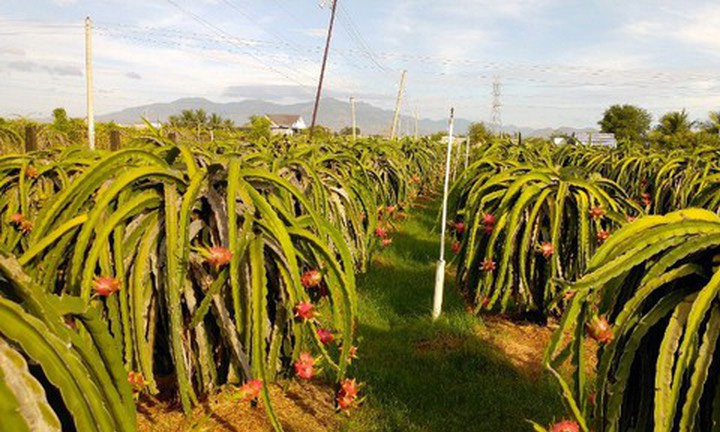SOURCE: Nguyen Tien, Saigon Online
On the morning of December 30, a representative of the Binh Thuan Province Dragon Fruit Association said that right after the Chinese market announced to temporarily halt the import of dragon fruit from Vietnam from December 29, 2021, to the end of January 26, 2022, because of the positive result with SARS-CoV-2 virus on the packaging and the fruit, the price of this fruit plummeted heavily.
Le Thi Phuong, a dragon fruit trader in Binh Thuan Province, said that by the morning of December 30, the price of high-quality dragon fruit for export was only VND5,000-VND7,000 per kg, down VND10,000 per kg compared to a few days ago. Meanwhile, no trader buys the low-quality one.
Nguyen Tri Thanh, a farmer in Ham Thuan Bac District in Binh Thuan Province, was shocked when he heard that after only a few days, the price of dragon fruits had decreased sharply compared to the previous week.
“My family has been using artificial lighting to produce off-season fruits on nearly 5,000 square meters of dragon fruit. At present, it is only 2-3 days left for dragon fruits to be ready for harvest. However, with the price of only a few thousand Vietnamese dongs per kg, my family will definitely suffer a heavy loss,” Thanh sadly said.
The household of Le Van Khai, a farmer in Ham Thuan Nam District, is also sitting on pins and needles because nearly a hectare of off-season dragon fruit of his family has been ready for harvest, but harvesting is still delayed to wait for the price to rise. “The production cost for off-season dragon fruit is extremely high. This year, the power, fertilizer, and labor costs are higher than last year, but traders only offer VND6,000 per kg of dragon fruits. At this price, my family will lose hundreds of millions of Vietnamese dong,” he said.
According to local farmers, the price of off-season dragon fruits must be over VND10,000 per kg for the grower to break even. With a price of only VND5,000-VND6,000 per kg, the grower will suffer a heavy loss. At the same time, dragon fruit growers often put a lot of expectations on the Tet crop. However, a sharp drop in dragon fruit prices has caused Binh Thuan farmers to struggle, not knowing how to handle the situation.
“In the next few days, the batch of off-season dragon fruits that serves the Tet market will be fully ripe, with a large output. If the export situation remains difficult, we can only dump our dragon fruits”, Khai worriedly said.
A representative of Binh Thuan Dragon Fruit Association said that the time when China halted the import of dragon fruits coincided with the peak of dragon fruit production and export to serve the Tet market of Binh Thuan Province, so it would greatly affect farmers and exporters.
Mr. Huynh Canh, Vice Chairman of Binh Thuan Dragon Fruit Association, said that exporting dragon fruits by road into the Chinese market could not pass customs clearance at present. Meanwhile, there were no containers to export dragon fruits by sea, so it was understandable when the price of dragon fruits plummeted.
“It takes about a month to export dragon fruit to China by road and nearly two months by sea, so dragon fruits are very difficult to preserve. Meanwhile, currently, the cost of exporting dragon fruit by sea is too high. Previously, a container of nearly 20 tons cost about VND60 million-VND70 million. Now, it reaches nearly VND200 million,” Mr. Huynh Canh emphasized.
Mr. Phan Van Tan, Deputy Director of the Department of Agriculture and Rural Development of Binh Thuan Province, informed that amid the situation that exporting dragon fruits to the Chinese market was difficult, the unit had informed households and businesses to have appropriate solutions for consumption and harvesting. It advised enterprises to strengthen the connection with domestic consumption and supermarkets to consume the amount of dragon fruits for farmers.
“The fact that China halted purchasing dragon fruits has greatly affected the production and consumption of dragon fruits in the province. We have advised farmers to have an appropriate plan for production and harvesting. At the same time, farmers need to reduce off-season production and wait for new information and recommendations from the authorities,” said Mr. Phan Van Tan.
According to statistics, Binh Thuan Province is the locality with the largest area of dragon fruit in the country, with over 32,000 hectares. Annual dragon fruit output reaches about 700,000 tons. About 80-90 percent of the dragon fruit output of the province is mainly exported to China through unofficial cross-border trade. The dragon fruit yield from July until the end of 2021 is expected to reach 437,000 tons.

